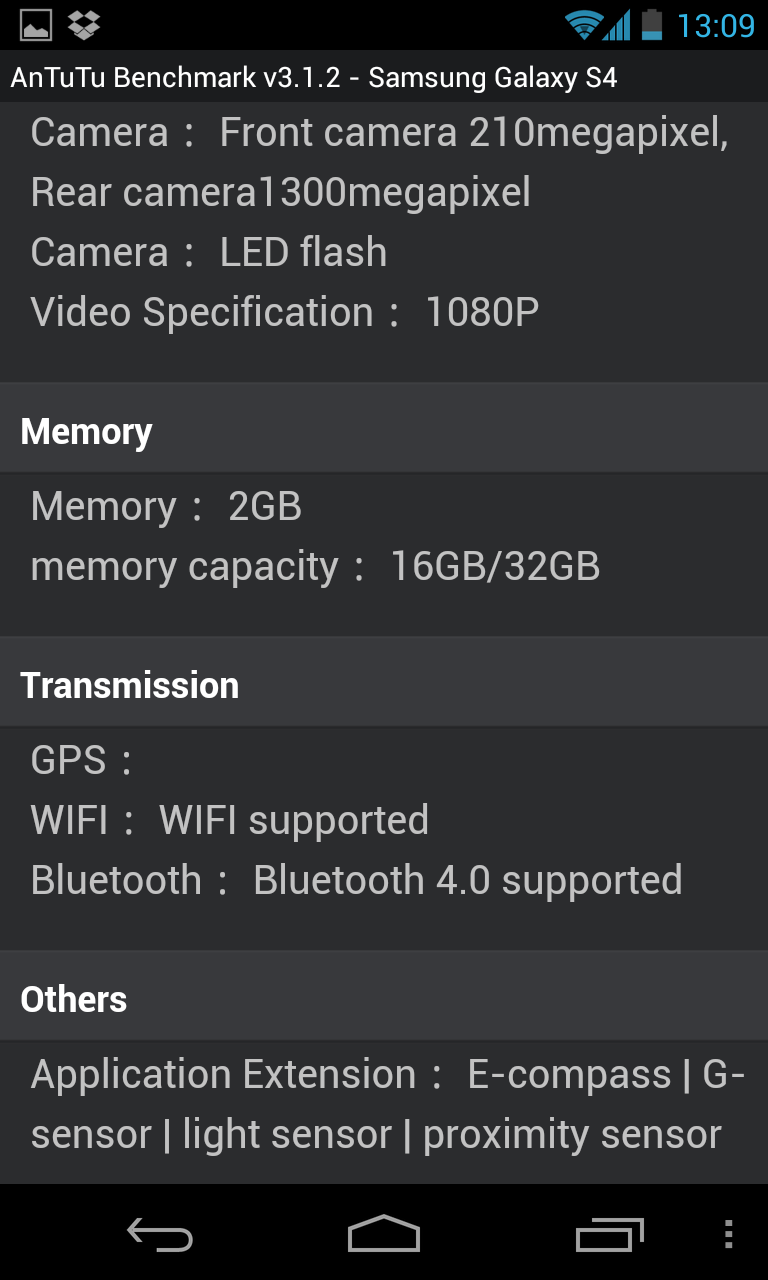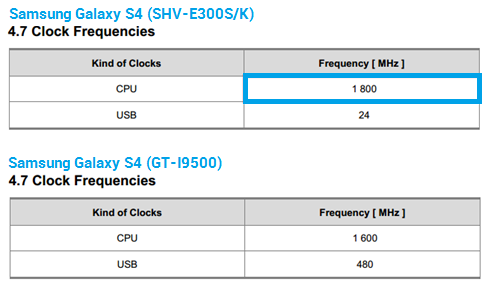Search result

Samsung after such a fine year with cellular devices is now working upon some fascinating accessories too. One of them is Exynos 5 octa processor; Samsung hasn't yet launched it but is teasing people with its pictures over twitter. The processor works upon 8 small and big powerful cores divided into two groups, one group is active at a time. 4 cores belong to Cortex-A15 and 4 to Cortex-A7. Cortex-A7 is smaller core in relation to A15 cores.
A7 cores are really efficient in terms of energy saving, although they are not as powerful as A-15 cores but are enough to run any device smoothly. A7-cores are only 13% less in terms of size in with A-15 cores. The shifting time between these two groups of cores is about 30-50 minutes. More details, could be unveiled at the launch of the phone, till then we can only rely on twitter pictures and rumors.
 '
'


Looks like Samsung Galaxy S IV will be the "2013 Smartphone of the Year" with its Exynos Octa CPU and a 544MP PowerVR SGX GPU. These were unwittingly or purposefully revealed by someone who performed benchmarking through Antutu. All other fantastic specifications include 2GB memory, almost 5 inches Full HD display with a resolution of 1920x1080 and running on Android 4.2 JB.
Furthemore, the Samsung Galaxy S IV supports all kinds of networks including LTE, which means that the company will only have one variant of this powerhouse device, since LTE connectivity is already included among the supported networks.
The Galaxy S IV will be officially launched on March 14th and this "leak" definitely tops them all. Please don't let this be a hoax! Also, is it safe to say that we've already seen the best kept secrets of the S IV or are they just starting yet?


The Galaxy S4 is the Samsung's latest flagship smartphone for 2013 but how does it stack up against the well-received HTC One performance wise? well, AndroidAuthority did a great job running the Benchmark on it.
As a quick hardware recap, the HTC One is running a Snapdragon 600 chip using a Krait 300 CPU clocked at 1.7Ghz, it's the same chip found in the most common Samsung Galaxy S4. The Galaxy S4 Snapdragon 600 is clocked slightly higher than the HTC One at 1.9Ghz, so we should already expect the Galaxy S4 to pull out slightly ahead. The Snapdragon 600 used in both handsets has an Adreno 320 for its graphics processor.
And the winner, without a surprise, by a decent enough margin, is the Exynos 5 Octa powered Galaxy S4.
Source: androidauthority


The Exynos 5 Octa was confirmed to be LTE-enabled and that it supports all 20 bands. This bit of info was taken from the SamsungExynos page on their Twitter account. This means that it can also do what the Snapdragon 600 (Qualcomm) is capable of doing. However, there are also reports (fom SamMobile) that the reason why the Galaxy S 4 came in two variants is that Samsung was unable to deliver the Exynos 5 Octa in time for the S 4 launch.
Furthermore, Samsung actually confirmed that they have just started mass producing the famed chip after the first quarter. According to the reports, only about 30% of the total Galaxy S 4 production have Exynos 5 Octa in their hardware and many are hoping for more Exynos variants to be distributed in the near future.


With all the hype and pomp that the Samsung Galaxy S 4 has created, one may think that it won't make much news anymore after the launch but to the contrary, it makes even more news from the features to the chips and the records it has broken. Tagged by many as the "Smartphone of the Year for 2013", it is also no secret that it comes in two different variants based on the type of processors used: the Exynos and the Snapdragon versions.
Now, FCC announces that the Korean variant uses an Exynos 5 Octa chip, clocking in at 1.8 GHz. Documents support this information and it couldn't come from a more reliable source. However, not everyone is happy that the Korean version sports a faster CPU than what most of the other S 4 customers will receive. The "Global" version will only run at 1.6 GHz.
Furthermore, the Korean S 4 will also support various bands of LTE. Some people have expressed disappointment over this, saying that everyone should have fair opportunity to get the faster variant, even if it means waiting for a longer period.

Samsung's Exynos 5 Octa series of mobile processors with ARM© big.LITTLETM technology now supports heterogeneous multi-processing (HMP)! This advanced technology allows the Exynos 5 Octa processors to provide exceptional performance and increased power efficiency. In the OCTA-pella video, you'll see how the Exynos 5 Octa uses ARM big.LITTLE processing to balance workloads across CPU cores, using the right core for the right task.
Press release:
Samsung Primes Exynos 5 Octa for ARM big.LITTLE Technology with Heterogeneous Multi-Processing Capability
Seoul, Korea, September 10, 2013
Samsung Electronics Co., Ltd., a world leader in advanced semiconductor solutions, today announced its Heterogeneous Multi-Processing (HMP) solution for the Exynos 5 Octa to fully maximize the benefits of the ARM® big.LITTLETM technology. The HMP capability gives system-level designers the ability to develop solutions that deliver the right combination of high-performance and low-power to carry out tasks such as 3D gaming, complex augmented reality and advanced web browsing.
"It's usually assumed that the big CPU will do all the performance-critical work, however, power-efficient little cores can handle many significant workloads all on their own, so the workload is balanced within the system," said Taehoon Kim, vice president of System LSI marketing, Samsung Electronics. "big.LITTLE processing is designed to deliver the right combination of processors for a specific job. An eight-core processor with HMP is the truest form of the big.LITTLE technology with limitless benefits to the users of high-performance, low-power mobile products."
"ARM big.LITTLE multi-processing technology delivers the highest performance and efficiency across the widest range of workloads," said Noel Hurley, vice president, Strategy and Marketing, Processor Division, ARM. "We welcome Samsung's continued commitment to deploying the leading-edge technology on their latest chips featuring the ARM CortexTM-A series of processors, ARM MaliTM GPUs and ARM ArtisanTM physical IP."
HMP is the most powerful use model for ARM big.LITTLE technology, as it enables the use of all physical cores at the same time. Software threads with high priority or high computational intensity can be allocated to the 'big' Cortex-A15 cores while threads with less priority or are less computationally intensive, can be performed by the 'LITTLE' Cortex-A7 cores, enabling a highly responsive, low-energy system to be built.
Software implementation is essential to maximizing the benefits of big.LITTLE technology. Multi-processing software controls the scheduling of threads of execution to the appropriate core. In earlier versions of the big.LITTLE software, the whole processor context is moved up to the 'big' core or down to the 'LITTLE' core based on the measured work load. In-depth study and analysis of diverse use case scenarios enable Samsung to achieve efficiency and high-performance, while managing power levels to deliver optimal user environments.
The HMP solution for Samsung's Exynos 5 Octa application processors will be available to customers in 4Q of 2013.
About Samsung Electronics Co., Ltd.
Samsung Electronics Co., Ltd. is a global leader in technology, opening new possibilities for people everywhere. Through relentless innovation and discovery, we are transforming the worlds of televisions, smartphones, personal computers, printers, cameras, home appliances, LTE systems, medical devices, semiconductors and LED solutions. We employ 236,000 people across 79 countries with annual sales exceeding US$187.8 billion. To discover more, please visit www.samsung.com.
Check out the video below:

A developer on XDA website has written a guide/information page so we stop as soon as possible the discussions about how 8 cores are useless.
The Exynos Octa or Exynos 5410 is a big.LITTLE design engineered by ARM and is the first consumer implementation of this technology. Samsung was their lead partner in terms of bringing this to market first. Reneseas is the other current chip designer who has publicly announced a big.LITTLE design.
The point of the design is to meld the advantages of the A7 processor architectures, with its extreme power efficiency, with the A15 architecture, with extreme performance at a cost of power consumption. The A7 cores are slightly slower than an A9 equivalent, but using much less power. The A15 cores are in another ballpark in terms of performance but their power consumption is also extreme on this current manufacturing generation.
ARM's initial tests show that a big.LITTLE processor running in HMP mode is 10% faster than a big.LITTLE processor running in migration mode but with the same power efficiency.
© 2023 YouMobile Inc. All rights reserved





